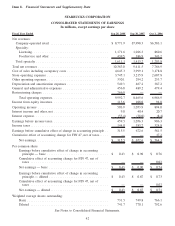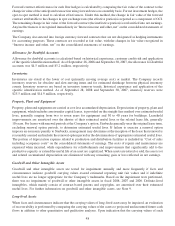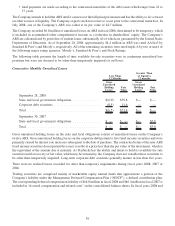Starbucks 2008 Annual Report Download - page 57
Download and view the complete annual report
Please find page 57 of the 2008 Starbucks annual report below. You can navigate through the pages in the report by either clicking on the pages listed below, or by using the keyword search tool below to find specific information within the annual report.For tenant improvement allowances and rent holidays, the Company records a deferred rent liability in “Accrued
occupancy costs” and “Other long-term liabilities” on the consolidated balance sheets and amortizes the deferred
rent over the terms of the leases as reductions to rent expense on the consolidated statements of earnings.
For premiums paid upfront to enter a lease agreement, the Company records a deferred rent asset in “Prepaid
expenses and other current assets” and “Other assets” on the consolidated balance sheets and then amortizes the
deferred rent over the terms of the leases as additional rent expense on the consolidated statements of earnings.
For scheduled rent escalation clauses during the lease terms or for rental payments commencing at a date other than
the date of initial occupancy, the Company records minimum rental expenses on a straight-line basis over the terms
of the leases on the consolidated statements of earnings.
Certain leases provide for contingent rents, which are determined as a percentage of gross sales in excess of
specified levels. The Company records a contingent rent liability in “Accrued occupancy costs” on the consolidated
balance sheets and the corresponding rent expense when specified levels have been achieved or when management
determines that achieving the specified levels during the fiscal year is probable.
When ceasing operations in Company-operated stores under operating leases, the Company accounts for any lease
contract termination costs in accordance with SFAS 146, “Accounting for Costs Associated with Exit or Disposal
Activities.” Accordingly, in cases where the lease contract specifies a termination fee due to the landlord, the
Company records such expense at the time written notice is given to the landlord. In cases where terms, including
termination fees, are yet to be negotiated with the landlord, the Company will record the expense upon signing of an
agreement with the landlord. Finally, in cases where the landlord does not allow the Company to prematurely exit its
lease, but allows for subleasing, the Company estimates the fair value of any sublease income that can be generated
from the location and records as an expense the excess of remaining lease payments to the landlord over the
projected sublease income at the cease-use date.
Asset Retirement Obligations
Starbucks accounts for asset retirement obligations under FASB Interpretation No. 47 (“FIN 47”), “Accounting for
Conditional Asset Retirement Obligations — an interpretation of FASB Statement No. 143,” which it adopted at the
end of fiscal 2006. FIN 47 requires recognition of a liability for the fair value of a required asset retirement
obligation (“ARO”) when such obligation is incurred. The Company’s AROs are primarily associated with
leasehold improvements which, at the end of a lease, the Company is contractually obligated to remove in order
to comply with the lease agreement. At the inception of a lease with such conditions, the Company records an ARO
liability and a corresponding capital asset in an amount equal to the estimated fair value of the obligation. The
liability is estimated based on a number of assumptions requiring management’s judgment, including store closing
costs, cost inflation rates and discount rates, and is accreted to its projected future value over time. The capitalized
asset is depreciated using the convention for depreciation of leasehold improvement assets. Upon satisfaction of the
ARO conditions, any difference between the recorded ARO liability and the actual retirement costs incurred is
recognized as an operating gain or loss in the consolidated statements of earnings.
ARO expense was $6.5 million and $4.2 million, in fiscal 2008 and 2007, respectively, with components included in
“Costs of sales including occupancy costs,” and “Depreciation and amortization expenses”. The initial impact of
adopting FIN 47 at the end of fiscal year 2006 was a charge of $27.1 million, with a related tax benefit of
$9.9 million, for a net expense of $17.2 million, with the net amount recorded as a cumulative effect of a change in
accounting principle on the consolidated statement of earnings for fiscal year 2006. As of September 28, 2008 and
September 30, 2007, the Company’s net ARO asset included in “Property, plant and equipment, net” was
$18.5 million and $20.2 million, respectively, while the Company’s net ARO liability included in “Other long-
term liabilities” was $44.6 million and $43.7 million, as of the same respective dates.
Stock-based Compensation
The Company maintains several equity incentive plans under which it may grant non-qualified stock options,
incentive stock options, restricted stock, restricted stock units (“RSUs”) or stock appreciation rights to employees,
non-employee directors and consultants. The Company also has employee stock purchase plans (“ESPP”). RSUs
51
























